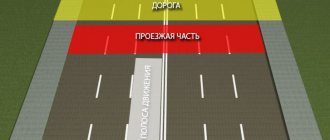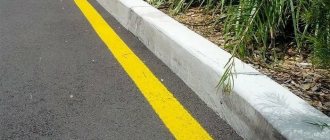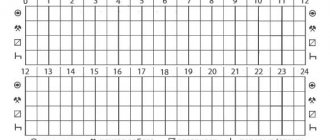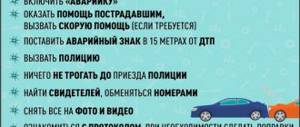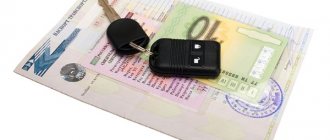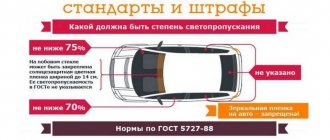In this topic, we will figure out why this sign was invented, what role it plays in traffic rules, because without knowing the basics of traffic rules, you can find yourself in an awkward situation, which will ultimately lead to an accident on the road.
Dear readers! Our articles talk about typical ways to resolve legal issues, but each case is unique. If you want to find out how to solve your particular problem, please use the online consultant form on the right or call. It's fast and free!
What does the road narrowing sign mean and what does it look like?
Road narrowing belongs to the category of warning signs and is installed:
- In the city, according to traffic rules, it is installed at a distance of approximately 100 meters from the beginning of the site
- Outside the city on the highway at a distance of an average of 200 meters.
- Outside the populated area, it is re-installed 50 meters before the dangerous area.
Even people who graduated from driving school a long time ago and may have forgotten some traffic rules will understand it. After all, there is nothing complicated in its structure. The sign itself looks like a triangle with a red border and signals a decrease in the number of lanes and the need to change lanes.
If a road sign has an unusual yellow background, this means it is temporarily in this place and is installed in places where road work is being carried out. But there are times when the one established in this place and the temporary one contradict each other. In this situation, you should be guided by temporary signs.
Types of road narrowing sign
It has three different types:
- 1.20.1 - the road narrows both on the right and on the left;
- 1.20.2 - the road narrows on the right;
- 1.20.3 - the road narrows on the left.
They all look almost the same.
Signs warn the driver that one of the lanes will soon end and there is a need to change lanes. Usually the sign is also accompanied by markings on the road, but if there are none, you should pay more attention to the signs.
1.20.1 - narrowing of the road on both sides is much less common than 1.20.1 and 1.20.2. It happens that a three-lane road turns into a one-lane one. In this case, you need to be even more careful, because cars change lanes on both the right and left into one lane, and you will need to know who is giving way to whom when changing lanes.
Cases when you may encounter this sign
Situations on the road are different. This sign can be found:
- in the city
- outside the populated area.
But it is quite difficult to find it in the city; it is usually replaced by road markings.
So, the main cases when you may encounter this sign:
- The sign is found in those places where one of the stripes ceases to exist. And it’s good if you know this section of the road and can change into the desired lane in advance, but for drivers who drive here for the first time, narrowing the road can cause a lot of trouble in the city. For example, you are driving through the city and see a narrowing road in front of you. You are faced with the need to change lanes, but there is a dense flow of cars in the adjacent lane, which does not give you room to maneuver. And you have to either slow down too much, or stop completely and wait until they let you pass or there is enough distance between the cars so that you can change lanes. But don't forget to turn on your turn signals when changing lanes.
- This sign can also be found at road work sites. As we said, its difference is the yellow background of the sign. In this case, the lane on the road is simply fenced off by road workers and it becomes temporarily inaccessible for traffic.
- The sign is installed in places where you exit from a minor road onto a wide highway or avenue.
- The sign can also be found before passing under a bridge, where the road usually narrows from several lanes in one direction to one lane.
Situations where there is no warning sign
There are also situations when there is no sign and the road narrows. What to do in this case? It's quite simple. You must follow other travel rules.
Considering that your lane is ending, when changing lanes you must give way to other cars moving without changing direction.
This is stated in rule 8.4, because when you change lanes into an adjacent lane, you will be an obstacle for other cars. And don't forget to turn on your turn signals to give advance warning of your maneuver.
At a crossroads
Often, after an intersection, two lanes in one direction turn into a single road, on which only one car can fit in width.
Ideally, in front of such junctions, signs are installed on which arrows indicate in detail the direction of movement, as well as the end of the lane. Correctly applied markings help even more to understand the traffic situation. The person driving the car must clearly understand that the vehicle that does not change the direction of its movement has the advantage.
In practice, drivers are guided by paragraph 8.9 of the traffic rules about “interference on the right”, so they try to be the first to enter the lane from the right lane. At the same time, they ignore the fact that the car changes its course, since straight-line movement would take it to the side of the road.
Most drivers, out of ignorance, let those on the right pass. This spontaneous movement is called “herringbone”.
According to the rules, it is the cars from the right lane that must give way, guided by paragraph 8.4 of the traffic rules!
Who must yield when approaching a narrowing road sign?
- According to traffic rules, the driver must give way to passing traffic. But it happens that the flow is too dense and there is practically no opportunity to change lanes into it. Usually, drivers have their own rules. Seeing that your road is narrowing, they may let you into the stream. But there are also situations at an intersection where not everyone is ready to yield, and in this case, be patient and wait, but remember for the future to change lanes in advance. Don’t forget that you don’t need to blatantly move into another lane, interfering with other road users, because you are not only breaking traffic rules by not giving way, but you can also get into an accident in which you are found guilty.
- When changing lanes from the right and left lanes at the same time, it is necessary to use the “right hand” rule, and in this case, the one with interference on the right must yield. Those. If you change lanes from the left lane and at the same time another car changes lanes from the right, then it is an obstacle for you on the right, according to this rule, it must pass first, and you give way to it. And vice versa, when you are trying to change lanes from the right lane, and at the same time a car is driving from the left lane, then you have the advantage. But do not forget that not all drivers can do this. For example, a young driver who has just graduated from a driving school may get confused on the road, or a very arrogant motorist for whom the rules are not written, in this situation it is better to give in to them so as not to end up in an emergency.
Always remember that compliance with traffic rules is the key to your safety. Never forget to look at the signs, because they are installed for a reason, but to warn drivers about a possible danger or situation on the road. And if you ignore them, you can get into an accident or find yourself in an incomprehensible situation on the road.
Didn't find the answer to your question? Find out how to solve exactly your problem - call right now: +7 (Moscow) +7 (812) 309-53-42 (St. Petersburg) It's fast and free!
Free online consultation with a car lawyer
Didn't find the answer to your question? Find out how to solve exactly your problem - call right now: +7 (Moscow) +7 (812) 309-53-42 (St. Petersburg) It's fast and free!
Who should give way when the road narrows without markings?
Good afternoon, dear car enthusiasts!
In this material we will consider the issue of priority when narrowing the road. With proper organization of traffic, the narrowing of the road is indicated by appropriate signs and markings, however, in practice, it is not uncommon for drivers to find themselves in a “neck” in the absence of means of organizing traffic.
For example, take the narrowing of the road at a bend.
Cars moving in two rows in the same direction are forced to divide the remaining lane among themselves. There are only two options, either the white car is inferior, or the blue one.
Basically, for this situation, drivers apply one of two points of the Rules of the Road.
- Some people consider this a rebuild:
8.4. When changing lanes, the driver must give way to vehicles moving in the same direction without changing direction. When simultaneously changing lanes of vehicles moving in the same direction, the driver must give way to the vehicle on the right.
For others, this situation is not regulated by the rules and they apply clause 8.9 of the traffic rules:
8.9. In cases where the trajectory of vehicles intersect, and the order of passage is not specified by the Rules, the driver to whom the vehicle is approaching from the right must give way.
Arguments for gaining an advantage from a white car: “I’m moving in the left lane, there are no obstacles in this lane, I’m not maneuvering, I’m not changing lanes, the blue car is changing into the left lane.
Arguments for gaining an advantage for the blue car: “The road is narrowing, two lanes end, only one remains and both cars simultaneously change lanes into this remaining lane” or “In this case, the order of passage is not specified by the rules, and the one with the obstacle on the right gives way "
It turns out that both cars have the right to count on an advantage, but this cannot happen. Therefore, let's analyze this road situation in detail. First, for convenience, we will “straighten” the road, since the bend itself has no direct relationship to the number of lanes on the road. From the point of view of the Road Traffic Rules, driving along a curved road is straight. All direction changes are made relative to the direction of the road. The fact of narrowing is important, but the narrowing along the radius or along the straight line does not matter.
In the absence of markings or road signs, the number of lanes is determined in accordance with clause 9.1 of the traffic rules
9.1. The number of lanes for trackless vehicles is determined by markings and (or) signs 5.15.1, 5.15.2, 5.15.7, 5.15.8, and if there are none, then by the drivers themselves, taking into account the width of the roadway, vehicle dimensions and required intervals between them. In this case, the side intended for oncoming traffic on two-way roads without a dividing strip is considered to be half the width of the roadway located on the left, not counting local widenings of the roadway (transition and express lanes, additional lanes on the rise, pockets of stopping places for route vehicles) .
At this point we see that the Traffic Rules determine the line of the middle of the roadway.
The next step is to determine the number of lanes.
“Traffic lane” is any of the longitudinal stripes of the roadway, marked or not marked with markings and having a width sufficient for the movement of cars in one row.
From the definition it follows that the lines of all lanes are located along the direction of the roadway. In our case, the edges of the roadway are narrowing, so you should start from the guide line, which is the axis of symmetry of the roadway, otherwise there will be a contradiction with the definition of the traffic lane and the lanes will not be longitudinal.
It is worth noting that the so-called counting of stripes from the center line is not a rule. The rules do not keep track of the number of lanes (the “second lane” is mentioned once in the rules for driving on a motorway). We need the center line to determine the direction of the roadway and to construct longitudinal stripes. The edges of the roadway can change and locally change direction, but the direction of the roadway does not change.
The center line always remains a guide line relative to the direction of the roadway, even if the center is determined taking into account local widening, it will be shifted, but the direction of the roadway will be determined correctly. The direction of the carriageway on a one-way road should be determined in the same way.
In this image you can see that the white car is moving without changing lanes, and an obstacle appears in the blue lane in the form of a narrowing of the roadway. Once again I would like to draw attention to the fact that the roadway is narrowing and to the determination of its middle in accordance with the Traffic Rules. The opinion that lanes should be counted from the edge of the roadway is erroneous. For clarity, let's shorten the narrowing interval.
At the very beginning, we mentioned that the narrowing of the road should be indicated by signs, but if there are none, it should be understood that the roadway is narrowing, it narrows accordingly not from the middle, but from the extreme borders, and the obstacle appears precisely on the strip closest to the border of the roadway.
Thus, the white car has the advantage.
For clarity, look at another perspective view:
Neither the direction of the road, nor the direction of the carriageway, nor the direction of movement changes, however, in order to continue moving, a car from the right lane in the forward direction must change lanes.
There is no reason to maneuver in the left lane. And of course, all drivers should not forget to maintain a safe interval.
. Unfortunately, the author of the request is not indicated.
Dear you without obstacles!
